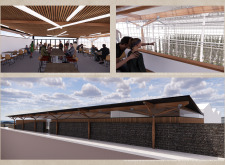5 key facts about this project
The design in the Mývatn region of Iceland focuses on creating a restaurant and greenhouse that tackle local agricultural challenges while supporting tourism. Set against the breathtaking landscapes of Mývatn, the project aims to promote sustainability and efficient food production. It also serves as a space for both locals and visitors to engage with the environment through a farm-to-table dining experience.
Design Concept
The building features a clear separation between the restaurant and the greenhouse, establishing distinct areas for dining and food cultivation. The restaurant is arranged in two levels. The upper level accommodates the dining area and kitchen, while the lower level includes food processing and mechanical systems. This organization enhances operational efficiency and allows for smooth connections between service and food production.
Sustainability Measures
Sustainability is central to the design, illustrated by the greenhouse's orientation, which maximizes solar gain during long summer days. The project incorporates rainwater harvesting for irrigation, highlighting a commitment to ecological practices. Additionally, design considerations for future growth allow for the expansion of the greenhouse, providing potential for increased food production.
Materiality and Interaction
A notable aspect of the design is the gabion stone wall made from locally sourced stones. This wall performs multiple functions; it serves as a visual anchor, provides thermal mass, and offers protection from the wind. The open design of the front kitchen encourages interaction between chefs and patrons, creating a space that fosters community and enhances the dining experience.
Visual Connectivity
The structure provides clear sightlines between the dining area and the greenhouse, allowing diners to see food preparation in action. This transparency reinforces the farm-to-table philosophy. Views of the Mývatn nature baths and Hverfjall volcano are prioritized, establishing a strong link between the architecture and the surrounding landscape. The relationship between the building and the natural environment enriches the overall experience, connecting visitors to the stunning geography of the region.





















































